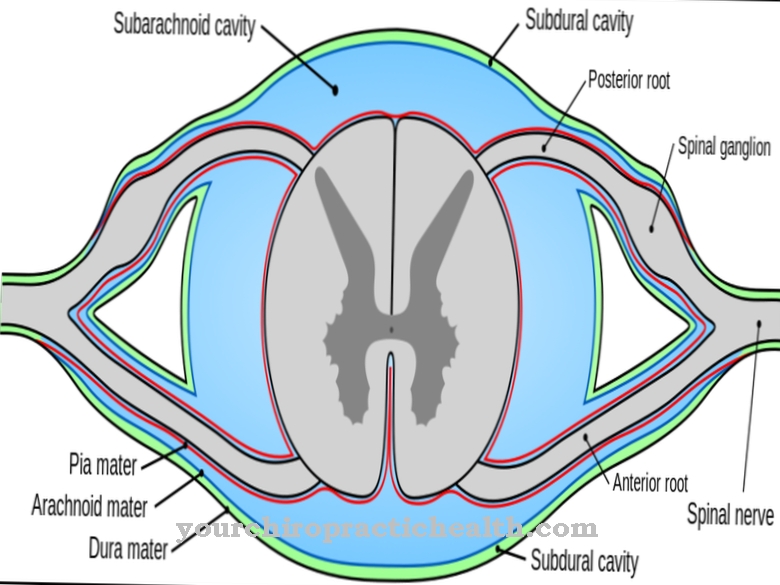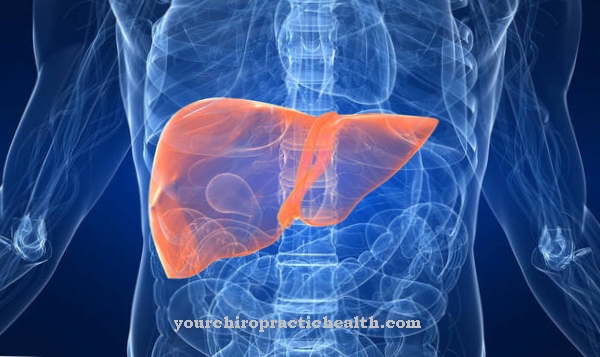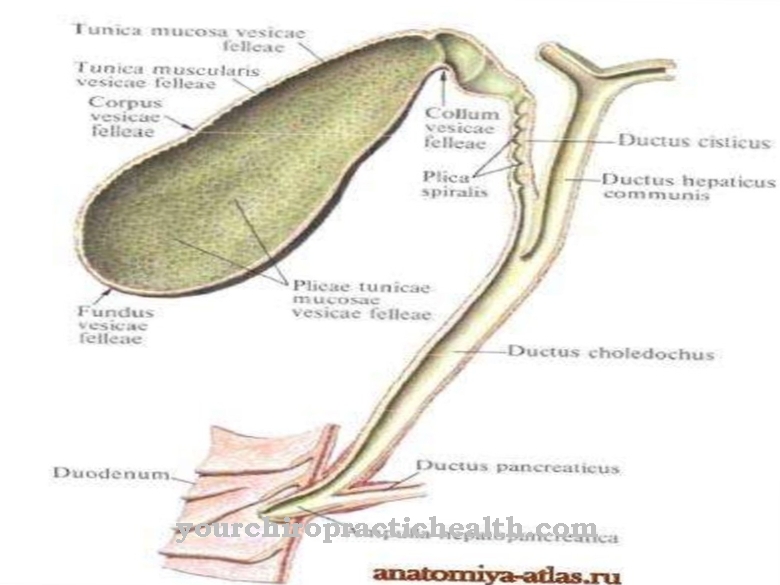The thyroid In addition to the hypothalamus and the pituitary gland, it is an important part of the thyrotropic control circuit. Disturbances of this hormonal control loop can lead to serious impairment up to a life-threatening metabolic derailment (thyrotoxic crisis).
What is the thyroid?

The Thyroid gland (glandula thyreoidea) is an endocrine gland that has a lobed, butterfly-shaped structure and below the larynx (larynx) surrounds the trachea (windpipe) in a semicircle from back to front.
On average, the thyroid gland weighs between 20 and 60 grams and plays an essential role in human metabolism. The thyroid gland mainly consists of microscopically visible thyroid follicles in which the protein thyroglobulin, a precursor of thyroid hormones, is stored and between which there are so-called C cells (calcitonin-producing cells).
In order to function properly, especially for the synthesis of thyroid hormones, the thyroid gland needs sufficient iodine, an essential trace element that reaches the hormone gland as iodide from the blood (iodination) and is oxidized and stored there to form elementary iodine (iodination).
Anatomy & structure
The thyroid is composed of the two lateral lobes, lobus dexter and lobus sinister, which are connected approximately between the 2nd and 4th tracheal ring via the so-called isthmus, a kind of tissue bridge, in front of the trachea and form a butterfly-like shape.
A further extension can often be found on this tissue bridge, which is a pyramidal rudiment from the embryonic development towards the thyroid cartilage (largest larynx cartilage) (lobus pyramidalis). In addition, the thyroid gland is enclosed by inner and outer connective tissue capsules, which ensure the connection with the surrounding structures such as the supplying vessels and nerves.
In addition, the connective tissue anchors the two lobes of the thyroid gland to the trachea. The thyroid has a very high vascularization (large number of blood vessels) and blood flow rate.
Functions & tasks
The main function of the thyroid consists in the storage of iodine for the synthesis and secretion (secretion) of the iodine-containing thyroid hormones and in the production of the peptide hormone calcitonin.
In the so-called follicular epithelial cells (thyrocytes) of the thyroid gland, the hormones thyroxine or tetraiodothyronine (T4) and triiodothyronine (T3) are synthesized, which increase the energy metabolism by expanding the vessels, stimulate the cells of the nervous system and increase heart rate, blood pressure and body temperature cause.
In addition, the thyroid hormones increase the sebum and sweat gland activity, collagen synthesis and intestinal motor skills and play an essential role in the organic development of newborns. Through their effect on the growth hormones IGF-1 (Insulinlike Growth Factor) and somatropin, they control growth and cell development. They also promote myelination (shedding) and differentiation of nerve cells.
The function of the thyroid gland is controlled by the superior pituitary gland (pituitary gland) and the hypothalamus (area of the diencephalon). In addition, the hormone calcitonin is produced in the parafollicular cells or C cells located between the follicular epithelial cells. Calcitonin has a reducing effect on the calcium concentration in the blood, since it inhibits the release of calcium and phosphate in the bones, while at the same time it stimulates the incorporation of these substances (mineralization).
The hormone also stimulates the release of phosphate, sodium, calcium, potassium and magnesium from the kidneys.
Diseases
Diseases of the thyroid are comparatively common and can generally be divided into three different sub-forms. If the thyroid hormone level is normal, it is called euthyroidism.
If the thyroid hormone metabolism is impaired, the hormone level is either increased due to an overactive thyroid (hyperthyroidism) or decreased due to an underactive thyroid (hypothyroidism). In hyperthyroidism, the body's energy expenditure increases, so that in many cases an overactive condition manifests itself through weight loss.
Palpitations and / or nervousness are other symptoms of an overactive thyroid. Hypothyroidism is divided into primary sub-functions, which can be traced back to impairments of the thyroid gland itself, and secondary sub-functions due to a disruption of the structures that control the thyroid gland (pituitary gland, hypothalamus). An underactive thyroid usually manifests itself in the form of bradycardia, listlessness, concentration disorders, sensitivity to cold, constipation and weight gain.
Regardless of the specific metabolic situation, the thyroid gland may be enlarged or normal in size due to the formation of a goiter (goiter). In the case of an enlargement of the organ with normal hormone metabolism, for example, doctors speak of euthyroid goiter, which, with an incidence of 30 to 40 percent of the population, is one of the most common diseases.
A severe goiter can narrow the windpipe and cause breathing difficulties. In addition, the risk of thyroid autonomy is greatly increased. Inflammation of the thyroid gland (thyroiditis) can in many cases be traced back to autoimmune diseases (Hashimoto's thyroiditis, Graves' disease) or noxae (drugs, chemotherapy). Malignant neoplasms (carcinomas) usually develop in the thyroid gland starting from thyrocytes or C cells.
Typical & common diseases
- Thyroid cancer
- Goiter (goiter, enlarged thyroid)
- Hyperthyroidism
- Hypothyroidism
























.jpg)



